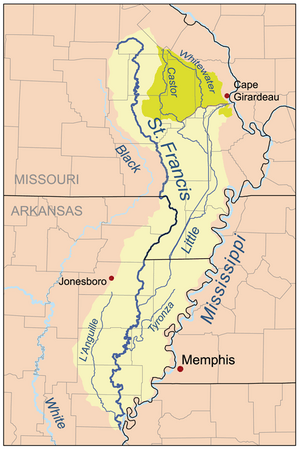Little River (St. Francis River tributary) facts for kids
Quick facts for kids Little River |
|
|---|---|

Map of the St. Francis River watershed showing Little River. The darker shade represents the Castor/Whitewater headwaters.
|
|
| Country | United States |
| States | Missouri, Arkansas |
| Physical characteristics | |
| Main source | Scott County, Missouri 37°02′45″N 89°45′24″W / 37.04583°N 89.75667°W 315 ft (96 m) |
| River mouth | St. Francis River 35°55′26″N 90°07′51″W / 35.9239612°N 90.1309271°W 230 ft (70 m) |
| Length | 148 mi (238 km) |
The Little River is a stream about 148 miles (238 km) long. It flows through southeastern Missouri and northeastern Arkansas in the United States. This river is a tributary of the St. Francis River, which means it's a smaller river that flows into a larger one. Through the St. Francis River, the Little River's water eventually joins the mighty Mississippi River. All the land that drains water into the Little River and then into the St. Francis and Mississippi Rivers is called its watershed.
Contents
The Little River: A Journey Through History and Nature
Where Does the Little River Flow?
The Little River starts in Scott County, Missouri. From there, it travels south through several counties in Missouri, including Dunklin, New Madrid, Pemiscot, and Stoddard. It then crosses into Arkansas. In Arkansas, the river flows through the Big Lake National Wildlife Refuge. This refuge is a special place that protects wildlife and their homes. Finally, the Little River joins the St. Francis River near Marked Tree.
How Humans Changed the River
Over time, people have made big changes to the Little River, especially in its upper parts in Missouri. These changes are called channelization. This means that parts of the river were straightened and deepened to help control floods and make land better for farming.
Originally, the Little River collected water from two other rivers, the Castor River and the Whitewater River. However, these rivers were later redirected. Their water now flows directly into the Mississippi River through a system called the Headwater Diversion Channel. This means the Little River no longer gets water from them.
The path of the Little River through the Missouri Bootheel (the southeastern part of Missouri shaped like a boot) was also changed into a canal. Even with these changes, you can still find parts of the river's original, natural path.
Why is it Called 'Little River'?
The name "Little River" probably comes from the French phrase La Petite Rivière. This means "The Little River" in English. It was likely given this name because it was smaller compared to other larger rivers nearby.

